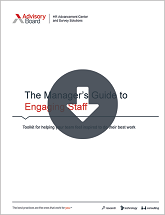Auto logout in seconds.
Continue LogoutThree things executives can do to get ahead of leader burnout amidst Covid-19
Motivation accounts for 40% of a team's success, yet managers often struggle to identify the right way to help unmotivated employees. Writing in Harvard Business Review, Richard Clark and Bror Saxberg explain the four common "motivation traps" that employees fall into and what managers can do to help them out.
When it comes to motivating employees, "the key is for managers to first accurately identify the reason for an employee’s lack of motivation and then apply a targeted strategy," Clark, a professor emeritus of psychology and technology at the University of Southern California, and Saxberg, VP of learning science at the Chan Zuckerberg Initiative, write.
But they warn, "Applying the wrong strategy (say, urging an employee to work harder, when the reason is that they're convinced they can't do it) can actually backfire, causing motivation to falter further."
That's why Clark and Saxberg identified the four "motivation traps" employees are most likely to fall into, and the strategies managers can apply to help their workers overcome them.
Motivation trap 1: 'I don't care enough to do this.'
One way employees become unmotivated is when their work doesn't connect with or contribute to something they value—a trap Clark and Saxberg call the "value mismatch."
To get employees out of this trap, Clark and Saxberg suggest that managers have a conversation to find out what their employees value. This way, managers can align future tasks with their interests.
Clark and Saxberg list four different types of values that managers should listen for:
- Interest value, or "how intellectually compelling a task is";
- Identity value, or "how central the skill set demanded by a task is to an employee's self-conception";
- Importance value, or how "crucial the task is to achieve the team's or company's mission"; and
- Utility value, which is "a measure of the cost of achieving (and avoiding) the task versus the … benefits of achieving."
In cases where the value mismatch is not clear, Clark and Saxberg write, "a manager's best bet is to try to appeal to multiple values."
Motivation trap 2: 'I don't think I'm able to do this.'
When employees feel that they are incapable of completing a task, "they won't be motivated to do it," Clark and Saxberg write. This is called the "self-efficacy trap."
To free an employee from this trap, managers can try a few strategies to build a sense of self-efficacy. These include pointing out times they've overcome a similar challenge in the past, giving the employee more difficult challenges, or making their current task seem more manageable.
"Often, employees who lack self-efficacy are convinced that succeeding at a particular task will require the investment of far more time and energy than they can afford," Clark and Saxberg write. "Explain that they have the ability to succeed but may have misjudged the effort required."
That said, Clark and Saxberg also warn that some employees fall into the opposite—and more difficult to manage—trap: They feel overqualified for their position. When overconfident people make mistakes, "they insist that it's the criteria for judging success on the task that is flawed, so they take no responsibility for their failures," Clark and Saxberg write.
"When dealing with such employees, it's important to avoid challenging their ability or expertise," they write. "Instead, demonstrate to them that they have misjudged the requirements of the task, and convince them that it requires a different approach."
Motivation trap 3: 'I'm too upset to do this.'
Employees who carry a lot of "negative emotions," sometimes caused by "anxiety, anger, or depression," are likely to lose motivation at work, Clark and Saxberg write.
In this case, the key for managers is not to show employees the right or wrong way but to "engage in active listening." Managers should reach out to the workers, find a quiet and private place to talk, and ask "what the employee believes is causing them to be upset." The goal of this conversation is not to agree or disagree with the employee, but to understand. After the employee is done explaining, take a moment to summarize what they said and ask if you understood.
"When people feel they have been understood, their negative emotions soften a bit. It may be useful to tell them that you want to consider what they told you and schedule a time the next day to discuss. This often helps the person get more control over their emotions."
Once an employer understands where a worker's negative emotions stem from, they can "[o]ffer [their] help." In more serious situations, Clark and Saxberg write, "it may be advisable to help the employee access counseling."
Motivation trap 4: 'I don't know what went wrong with this.'
Employees fall victim to when Clark and Saxberg call the "attribution error trap" when they "can't accurately identify the reason for their struggles with a task." Usually, employees in this trap think they struggle to carry out certain tasks in a reasonable time because of reasons that are out of their control like simply not having enough time or falling ill.
In cases like these, managers should help their workers identify the root cause of their struggle, and from there, managers can help the employee identify solutions they can control, such as trying a new approach, according to Clark and Saxberg.
"If they identify a cause that's out of their control (blaming other people, for example, or a flaw in themselves that can't be fixed), suggest other causes that are under their control, such as the need to adopt a new strategy or to apply a greater level of planning," they write (Clark/Saxberg, Harvard Business Review, 3/13).
Advisory Board's take


Kate Vonderhaar, Practice Manager, HR Advancement Center and Micha'le Simmons, Senior Consultant, HR Advancement Center
Another key reason that employees may lose their motivation is that they don't feel their hard work is being recognized. A study published in the Harvard Business Review found that 82% of employed Americans don't feel like their supervisors recognize them enough for their contributions. And this hurts their motivation and productivity—40% of them say they'd put more energy into their work if they were recognized more often.
And yet, while many health care managers know that regularly recognizing employees is important, it can be hard for them to find the time to do so consistently. Today's managers are often pressed for time, juggling multiple responsibilities, and, for some, positive feedback may not come naturally.
Fortunately, recognizing staff doesn't have to be difficult or time-consuming—and it can cost little to nothing. Here are three simple techniques that you can embed into your routine, based on our work with the hundreds of organizations that use Advisory Board's engagement survey.
- Build a ready-to-use 'thank-you note toolbox.' Employees always appreciate in-the-moment verbal recognition, but a handwritten note mailed to a staff member's home can go even further to make someone feel valued and recognized.
Of course, many managers aspire to regularly share personal notes to thank staff for their work. But in the real world, it's all too easy to put off writing the notes, especially if managers have to hunt for stamps, note cards, and their employees' addresses.
The solution is to build recognition into your routine by creating a simple toolbox that includes all of the supplies you need to create handwritten thank-you notes. Senior leaders can chip in by helping assemble the kits for managers along with quick tips on how to write meaningful notes.
- Set a specific, short-term team goal, and reward staff for nailing it. Managers want to celebrate their team's performance—as they should! But too often, they reward staff for one-off accomplishments that may or may not accurately reflect the team's performance. As a result, teams rarely know what they need to do to earn recognition.
A better approach is to clearly define short-term goals with staff in advance.To get you started, we've assembled a list of suggested team goals—ranging from the rates of specific hospital-acquired infections to percentages of co-pays collected, depending on your team's focus—along with ideas for meaningful rewards.
Rewards don't have to be monetary; even an option to wear jeans on Friday can work. The most important part is that your team knows their goal is in advance so they know exactly what they need to do to be recognized.
- Offer a 'compliment jar' to make it easy for peers to recognize each other.Managers don't have to be the sole source of recognition. Recognition from peers is also meaningful to staff.
An easy way to encourage peer recognition is to set out a "compliment jar" in a high-traffic area in their unit or department, along with slips of paper for staff to share positive feedback about their peers.
Teams can kick off or close meetings by reading the collected compliments aloud—a great way to publicly recognize individual staff, and to encourage everyone to stay on the lookout for peer behavior to celebrate.
For more details on the suggestions above and 17 additional easy-to-use tools, download our full Manager's Guide to Engaging Staff. Then, be sure to download our new infographic to make sure you're not falling for these 5 myths of staff engagement.
Download the Guide Get the Infographic
Next, read our how-to guides for being a better manager
You can't succeed without a qualified and motivated staff. Download our "Manager's Guide" series to learn best practices for conducting interviews, onboarding new hires, and conducting performance reviews.
Don't miss out on the latest Advisory Board insights
Create your free account to access 1 resource, including the latest research and webinars.
Want access without creating an account?
You have 1 free members-only resource remaining this month.
1 free members-only resources remaining
1 free members-only resources remaining
You've reached your limit of free insights
Become a member to access all of Advisory Board's resources, events, and experts
Never miss out on the latest innovative health care content tailored to you.
Benefits include:
You've reached your limit of free insights
Become a member to access all of Advisory Board's resources, events, and experts
Never miss out on the latest innovative health care content tailored to you.
Benefits include:
This content is available through your Curated Research partnership with Advisory Board. Click on ‘view this resource’ to read the full piece
Email ask@advisory.com to learn more
Click on ‘Become a Member’ to learn about the benefits of a Full-Access partnership with Advisory Board
Never miss out on the latest innovative health care content tailored to you.
Benefits Include:
This is for members only. Learn more.
Click on ‘Become a Member’ to learn about the benefits of a Full-Access partnership with Advisory Board
Never miss out on the latest innovative health care content tailored to you.

